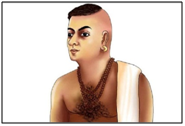

ArattupuzhaVelayudhaPanicker
Context
A recently-released Malayalam film PathonpathamNoottandu is based on the life of ArattupuzhaVelayudhaPanicker, a social reformer from the Ezhava community in Kerala in 19th century.
About
Who was ArattupuzhaVelayudhaPanicker?
- He was a social reformer from the Ezhava community in Kerala who lived in the 19th century.
- He was born into a well-off family of merchants in Kerala’s Alappuzha district.
- He was given the title of ‘Panicker’ by the then-king of Travancore in 1869.
- Panicker was murdered by a group of upper-caste men in 1874 at the age of 49. This makes him the ‘first martyr’ of the Kerala renaissance.

Panicker’s role in initiating social reforms:
- Panicker is credited with building two temples dedicated to the Hindu god Shiva, in which members of all castes and religions were allowed entry.
- One was built in his own village Arattupuzha in 1852
|
Post Death Recognition: In 2005, the Kerala government inaugurated the ArattupuzhaVelayudhaPanicker Research Foundation and Cultural Centre in Thiruvananthapuram |
-
- One in Thanneermukkom in 1854, another village in the Alappuzha district
- Some of his most significant contributions were in protesting for the rights of women belonging to Kerala’s backward communities.
- In 1858, he led the AchippudavaSamaramstrike at Kayamkulam in Alappuzha.
- This strike aimed to earn women belonging to oppressed groups the right to wear a lower garment that extended beyond the knees.
- In 1859, this was extended into the EthappuSamaram, the struggle for the right to wear an upper body cloth by women belonging to backward castes.
- In 1860, he led the MukkuthiSamaram at Pandalam in the Pathanamthitta district, for the rights of lower-caste women to wear ‘mukkuthi’ or nose-ring, and other gold ornaments.
- These struggles played an important role in challenging the social order and in raising the dignity of women belonging to the lower strata of society in public life.


